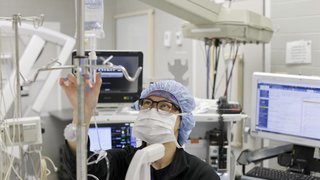Penile implants offer hope to men living with erectile dysfunction
June 28, 2024

In the U.S., 30 million men – about the population of Texas – live with erectile dysfunction (ED). That’s a lot of men who are enduring, usually in silence, a condition that can be a result of prostate cancer, diabetes, pelvic trauma, cardiovascular disease, or aging.
Medications for ED, or difficulty achieving and maintaining an erection, have become well known (who hasn’t seen a Viagra or Cialis commercial on TV?) and they remain the first-line treatment for this condition. But for men who are unable to take the pills, such as some heart patients or those with genitourinary injuries, there is a highly effective surgical treatment option available.
At UT Southwestern’s Department of Urology, we have been recognized as a Center of Excellence for a state-of-the-art penile implant that can help a patient get an erection on demand using a discrete, implanted pump about the size of a walnut.
The AMS 700™ Inflatable Penile Prosthesis (IPP) is implanted into the penis, scrotum, and lower abdomen during a one-hour, minimally invasive procedure.
Depending on their condition, patients who receive an IPP will still be able to enjoy orgasm and ejaculation. IPPs have a high reported rate of patient happiness, with its manufacturer finding over 98% of men reporting satisfaction.
Before coming to UT Southwestern, I was a lieutenant colonel in the U.S. Army, where I treated soldiers who sustained wounds while serving in Iraq and Afghanistan. I’ve seen firsthand how invisible wounds can linger the longest. Men with ED deserve to feel confident, enjoy sex, and please their partner again.
As the first surgeon in Texas to be recognized by the IPP’s manufacturer, Boston Scientific, as a Center of Excellence for this device, I am eager to share this treatment option with our ED patients and provide a safe treatment option that can improve their quality of life.

How does the IPP work?
First, it helps to understand what happens in the body during an erection. During arousal, the brain releases chemicals that increase blood flow to the penis through two central arteries into the corpus cavernosum – two spongy cylinders full of thousands of caverns. The blood fills the caverns, making the penis rigid. This blood compresses and closes off the veins that would normally drain the blood away, keeping the penis in this rigid state.
The IPP mimics a natural erection by directing fluid into cylinders implanted in the penis. There are four main parts of the device.
- Cylinders: Flexible tubes made of silicone and Dacron fabric that are surgically implanted into the erectile chambers of the penis. These cylinders fill with fluid (usually saline solution) during the inflation process, mimicking a natural erection. The cylinders are 12-18 millimeters in diameter and 4.5 to 9.4 inches long.
- Reservoir: This small container stores 65-100 milliliters of fluid used to inflate the cylinders and is connected to the pump bulb and the cylinders through a 3.5- to 7-inch tubing system. It is typically implanted in the lower abdomen, near the bladder.
- Pump bulb: This small component about the size of a walnut is connected to the IPP, typically in the scrotum, and transfers fluid into the cylinders when squeezed
- Deflation button: Located on the pump bulb, this button releases the fluid from the cylinders back into the reservoir, deflating the cylinders.
When a patient wants an erection, he squeezes the pump in the scrotum. Liquid from the reservoir in the lower abdomen will fill the cylinders in the penis, making it erect. After sex, the man simply presses the button near the pump to deflate the implant. The fluid will move back to the reservoir, and the erection will cease. The prosthesis is quiet and discreet, and it is completely internal.
Related reading: Men: Manage enlarged prostate symptoms without the risk of ED
Who is eligible for the IPP?
To be eligible for the IPP, patients must have erectile dysfunction all or some of the time. Because the IPP involves surgery under anesthesia, we recommend men try first-line treatments for ED first, including:
- Oral medications: Prescribed drugs such as sildenafil (Viagra), tadalafil (Cialis), and vardenafil (Levitra) increase blood flow to the penis.
- Alprostadil injections: This medication is injected directly into the base or side of the penis. It works by dilating blood vessels and increasing blood flow to help produce an erection.
The IPP has been particularly beneficial for patients with ED caused by:
- Prostate cancer. Surgery and radiation to treat prostate cancer can damage essential nerves and vessels for maintaining an erection.
- Radiation therapy. It’s estimated that having both radiation and prostate removal causes erectile dysfunction in 85% of men having those procedures.Overall cardiovascular health. It can affect blood flow and vascular function essential for achieving and maintaining erections.
- Diabetes. This condition damages blood vessels throughout the body, including the penis. One study found that 59% of diabetic males have ED.
- Traumatic injury to the pelvis.
How is the surgery performed?
We’ll make two incisions. The first is at the base of the penis to insert the cylinders, pump bulb, and deflation buttons. The second is in the lower abdomen to insert the reservoir. Surgery usually takes about one hour, patients are under general anesthesia, and they’re able to go home the day of the procedure.
The implant can’t increase the size or width of the penis, but we do customize the implant to precisely fit each patient while in the operating room.
"The prosthesis is quiet and discreet, and it is completely internal."
Steven Hudak, M.D.
What does recovery entail?
Most people will do fine with over-the-counter pain medications, though we may prescribe something stronger for someone who is in a lot of pain. Urination won’t be affected by the procedure; we use a catheter during surgery, but one won’t be needed afterward.
Patients can expect to be swollen and sore during recovery. I tell patients with desk jobs to plan on two weeks off, though most people will be ready to go back to work within a week. People with more active jobs should plan on a month off, but they’ll likely be ready within two to three weeks. However, it’s important to abstain from sexual activity for at least six weeks.
About three weeks after surgery, we ask patients to come into the office and we teach them how to inflate and deflate the device, which is intuitive. Most patients will get it after a few tries. For those who are too sore or have anxiety about using the IPP, additional counseling might be needed.

Will sex feel normal afterward?
Most people will still be able to orgasm. If a patient’s prostate was removed, and that’s the reason he is interested in an IPP, he won’t be able to ejaculate. That’s because the prostate creates the fluid that semen is carried in. However, he’ll still be able to feel the mental and physical sensations of orgasm.
How long does the implant last?
The average lifespan of an IPP is 15 years. The procedure for replacing an IPP is the same as the first time. If a patient chooses to no longer use the IPP, there’s nothing that needs to be done. The IPP can remain in the body indefinitely without causing harm.
The neurological and cardiovascular systems must work together to make it possible for the penis to give and receive pleasure. This delicate dance of chemicals and vessels is easily disrupted, especially for patients with diabetes and prostate cancer. The IPP can restore confidence, deepen partnerships, and enhance quality of life for ED patients.
To find out whether you might benefit from the IPP, call 214-645-8300 or request an appointment online.











